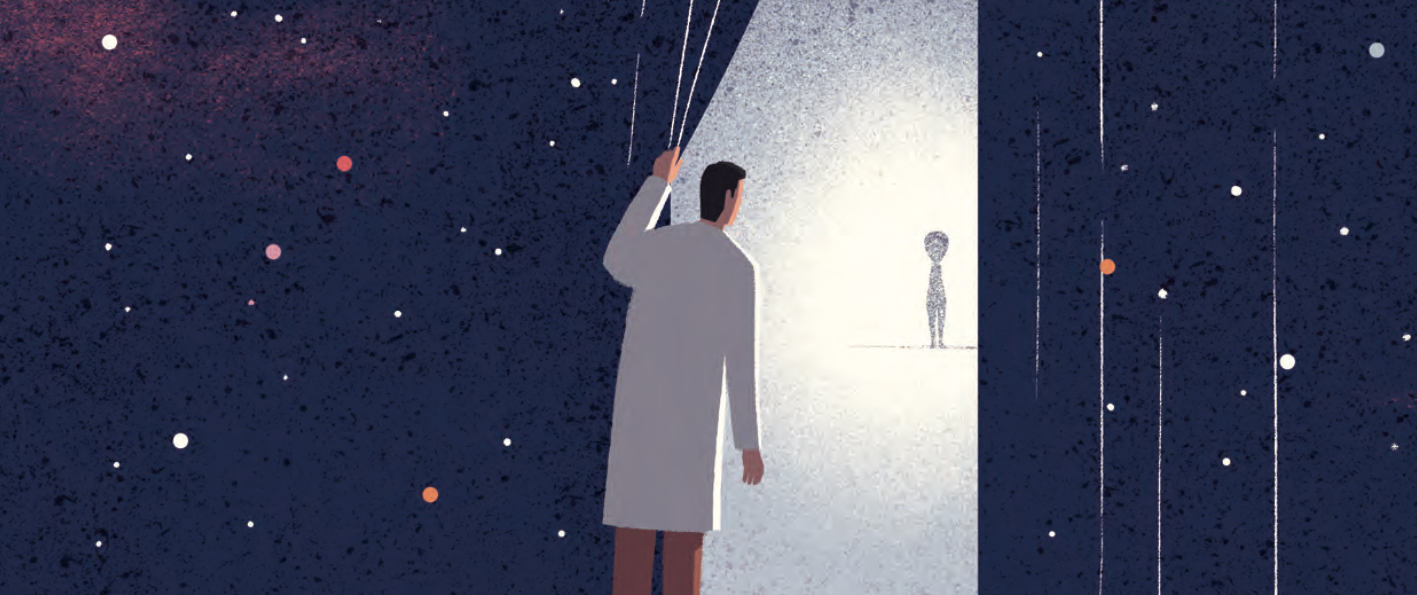
For the past six years, a van-sized NASA spacecraft called Kepler has been orbiting the sun, following the same elliptical path as Earth but trailing a few million miles behind us. This two-thousand-pound hunk of aluminum and electronics, carrying one of the most sensitive telescopes ever built, has been drifting off our tail, rather than orbiting us the way many space observatories do, so that it can enjoy an unobstructed view of the heavens. Its mission is to spot previously unknown planets orbiting distant stars — an extraordinarily difficult task for the simple reason that planets are small and dark, while stars are big and luminous. Kepler pulls this off by sensing a planet when it passes in front of its star, momentarily blocking a tiny amount of light, like a moth flitting across a porch lamp. Many astronomers, including me, believe that this planet-hunting expedition is providing us clues to one of the greatest mysteries that humans have ever pondered: whether extraterrestrial life exists.
The possibility that we are not alone in the universe, and that other intelligent creatures are strolling around on their own Earth-like planets somewhere, has been a subject of serious speculation among astronomers since at least the sixteenth century. That is when Nicolaus Copernicus triggered an intellectual revolution by suggesting that Earth is not the center of the universe. His insight inspired jaw-dropping discoveries by Galileo Galilei and others who realized, over the following centuries, that the sun is merely another star, that the stars we see in the nighttime sky are a tiny fraction of those that exist, and that the universe has no center. By the late eighteenth century, many scientists subscribed to a view that remains popular among both laypeople and astronomers today: that given the immensity of this decentralized cosmos, life must exist somewhere else. The alternative — that our sun, among the unfathomably large number of stars out there, is the only one supporting life — seemed faintly ludicrous.
Until very recently, though, we lacked the technology to see if other Earth-like planets were indeed orbiting any of the hundreds of billions of stars surrounding us. This effectively stalled scientific progress in learning whether we are unique, obscuring the true nature of our existence. No amount of philosophical reasoning could overcome this ignorance.
That veil may be lifting. In the past year alone, astronomers have identified nearly one thousand planets in other star systems — or exoplanets — based primarily on Kepler’s observations. These discoveries have more than doubled the number of known exoplanets, bringing the total to about 1,900. This number is expected to increase steadily over the next couple of years as scientists pore over Kepler’s vast trove of data.
Both the number and variety of exoplanets found so far have astounded even seasoned scientists. Whereas the first exoplanets discovered back in the mid-1990s were massive gaseous beasts with a passing resemblance to Jupiter — these behemoths were the easiest to spot — we’ve since identified exoplanets of nearly every conceivable size and character. Some are orbiting stars so closely that their surface temperatures are likely to be more than a thousand degrees, causing heavy iron-rich rock to gasify, forming clouds and then condensing as metallic raindrops. Others are likely to be icy snowballs plunged into permanent winters so deep that their atmospheres have frozen and fallen to the ground. Still others follow orbital patterns that suggest they may have atmospheric conditions that resemble Earth’s. In fact, based on our observations to date, we can extrapolate that roughly one out of every two stars in our Milky Way galaxy has an Earth-sized planet orbiting it, and that almost 30 percent of these planets orbit their stars at distances that could perhaps allow for surface environments with liquid water — that marvelous enabler of known biochemistry. This suggests that there are tens of billions of such worlds in the Milky Way alone.
The idea that our galaxy is teeming with other Earths is thrilling just to think about. But we can now do more than that. Today, many astronomers, biologists, chemists, physicists, geologists, and others are coming together to share data, ideas, and analytic techniques in hopes of answering questions that just a generation ago were not considered valid lines of scientific inquiry — questions like: How much life is out there? If life exists elsewhere in the universe, what form might it take? Is it likely to follow the same rules as life on Earth? Might it be reflecting intelligently on its own existence as we are?
Like many scientific revolutions, the one occurring now in this interdisciplinary field of astrobiology is fueled by technological innovation. Yet the next challenge we face puts us in a cosmic Catch-22. If we are to ascertain whether life exists on one of these distant planets, we need to build even more sensitive telescopes. And yet to design the right telescopes, we need to learn more about what we’re looking for. We need to figure out ahead of time what kinds of clues are indicative of an active biosphere.
To address this question, astrobiologists and astrophysicists are now collaborating with climate scientists, whose computer models of Earth are being adapted to create virtual alien worlds. Some of this work is being pioneered at Columbia, where researchers led by Anthony D. Del Genio, an adjunct professor of earth and environmental sciences and a member of the NASA Goddard Institute for Space Studies, are building simulations of hypothetical planets replete with pulsing atmospheres, oceans, and starlight to provide them with energy. To test their methods, they are creating simulacra of ancient Mars, ancient Earth, and ancient Venus. Millions of lines of computer code are being scrutinized and updated. Soon the scientists will build ice worlds, ocean planets, bigger Earths, smaller Earths, some spinning rapidly and others slowly, some frothing with biological activity and others barren. Hopefully these models will help teach us how to detect life’s fingerprints: atmospheric imbalances of compounds like oxygen or methane, or perhaps the infrared energy leaking from technological civilizations. As these virtual worlds are permitted to take their imaginary course, Del Genio and his colleagues will learn how to build tools to discriminate between habitable and uninhabitable worlds.
In searching for life outside our solar system, astrobiologists have until now focused mainly on observing planets that orbit stars similar to our sun in age and composition. But many of us believe that we could be limiting ourselves unnecessarily. To get a better idea of what star systems are worth investigating, we are now working with scientists who study the chemistry of both the ancient universe and the frigid interstellar regions where stars and planets form. Among these researchers is Columbia astrophysicist Daniel Wolf Savin ’85CC, who has built a sophisticated experiment at the University’s Nevis Laboratories in Irvington, New York, in which he re-creates the harsh conditions of interstellar space and then tries to coax delicate molecules like water and carbon compounds into being. By measuring the ease with which these reactions take place, he is giving us a better idea of what environments might sustain the full range of elements and organic materials necessary for life as we know it.
What might extraterrestrial life be like, should we find it? The truth is that we have absolutely no idea. If the study of distant planets has taught us anything so far, it is that diversity rules. A rainbow of cosmic conditions exists: variations in chemistry, climate, and the vagaries of each planet’s unique history. Even if life here on Earth is built from a universal toolkit, it seems possible that life could turn up in altogether unfamiliar forms elsewhere. Who is to say, for instance, that life must consist of discrete, self-replicating organisms that move around independently, competing, cooperating, and mating with one another? Might it instead be a dispersed web of organic material that metabolizes energy, processes sensory information, and thinks as a unified entity — not unlike a biological version of our vast Internet? The ideas of science fiction could yet turn out to be reality. It is useful to remember that life on Earth is the result of a particular chain of evolutionary events that, in hindsight, seem miraculously serendipitous. If this story were written on another world, around another star, beginning at another moment in the universe’s history, the outcome might shock us.
Some surprises may come from environments right here in the solar system. Icy moons like Jupiter’s Europa and Saturn’s Enceladus erupt with geyser-like plumes of salty water, offering a taste of what must be immense interior oceans. There is now intense interest in whether the bases of these abyssal realms, where water meets rock hundreds of miles down, might create analogs to the hydrothermal systems we find on Earth. Are these places where cave-dwelling life can flourish? Some scientists have suggested that life on Earth could have originated in parts of the deep terrestrial biosphere, which calls into question whether the same could have happened in a moon like Europa. Meanwhile, some of us are wondering if life on Earth might have originated elsewhere, perhaps on Mars or some nearby icy moon, and migrated here — or alternately, if simple Earth organisms might have at some point colonized a neighboring planet or moon. We’re dreaming up experiments to test the ability of microbes to survive transfer between worlds on chunks of material chipped from planets by asteroid impacts, tests that could one day fly on the International Space Station.
It may also be the height of conceit to think that terrestrial life couldn’t originate multiple times from scratch, perhaps even rewiring the basics of biology each time. Some scientists today are searching Earth for evidence of what is commonly called “weird life,” or life forms that utilize alternative biochemistries and thus evade our normal tools for studying living things. A few years ago the possibility of arsenic-based life in a California lake made headlines, and although it turned out to be spurious, many astrobiologists continue to believe there is value in challenging the status quo.
Preparing for the unexpected in astrobiology isn’t just a psychological exercise; it’s a critical part of the scientific process. We’ve only had one history, one living planet, to work with so far. Change this and you change the rules of the game.



